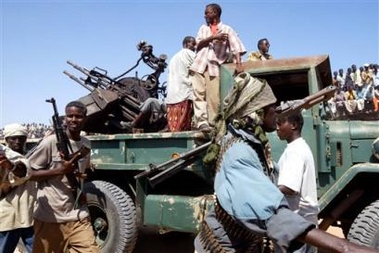
The extensive fighting in Mogadishu over the last week has brought Somalia back to international attention for a few days. Described as “a proxy battle between al-Qaeda and Washington”, this would seem to be over-egging the cake but not completely wrong.
The fighting is between a bunch of Mogadishu warlords who have delightfully re-branded themselves the “Alliance for the Restoration of Peace and Counter-Terrorism” (who might as well have just gone the whole hog and called themselves “Team America, F*ck Yeah!” - a joke for the South Park fans, please ignore if you aren't!) and the militias of the “Islamic Courts”. Connecting the courts to al-Qaeda is a stretch, as they have only recently and rather tenuously been connected to local Jihadi activists. The al-Qaeda affiliated Jihadi group in Somalia that people who are interested in these things tend to have heard if is al-Ittihaad al-Islami (AIAI). It appears to have its origins in the spread of Saudi-sponsored Salafi ideas to Somalia in the 1970s, and emerged in the 1980s as a party of dawa (preaching). It was not until the collapse of the Somali state in 1990 when Siad Barre was deposed that they began to take up arms. They involved themselves in the ethnically-Somali areas of Ethiopia in the 1990s committing acts of terrorism against the Ethiopian state. Any interest in the group in the West seems only to have come once they involved themselves with al-Qaeda operatives in the mid-1990s who were preparing for the bombings of the US embassies in Nairobi and Dar es-Salaam in 1998, but it was their acts in Ethiopia that led to their downfall. In 1996 and early 1997 the Ethiopian army took advantage of the fact that Somalia had no government to complain and entered the country attacking AIAI’s camps and killing many of its members. Since that time AIAI has faded from sight; some still believe it exists as an organisation but the Crisis Group does not believe this is the case (p.9-10) – pointing out that many of its former leaders have now taken up public and non-revolutionary positions in Somali life. One of still radical former-AIAI leaders, Hassan Dahir Aweys, seem to be the ideologue leading Aden Hashi ‘Ayro, the leader of a new, nameless Jihadi group which is active now in Somalia and has been linked to numerous murders of foreign aid workers in the country and other terrorist acts. ‘Ayro and his militia is also said to be now sheltering foreign al-Qaeda members in Mogadishu, including individuals that the US has sought ever since the embassy bombings.
The Islamic or Shari’a courts that are providing a type of justice system across southern Somalia are in the words of the Crisis Group: “widely touted as the most visible evidence of the creeping influence of Islamist groups. Most courts, however, are less a product of Islamist activism than of Somalia’s two most common denominators: clan and the traditional Islamic faith.”(p.19) And further that: “their heterogeneous membership and the diversity of their supporters mean that attempts to label the Shari’a system ‘extremist’, ‘moderate’ or any other single orientation are futile. In reality, the courts are an unwieldy coalition of convenience, united by a convergence of interests.”(p.21) They have gained much public support even from those who really do not agree with their conception of Shari’a because they have brought a degree of order to a lawless society, paralleling in many ways the rise of the Taliban in Southern Afghanistan in the mid-90s. What started as independent courts generally operating for distinct clans has become a wider system led by “the Supreme Council of Islamic courts”. Individual courts contribute militia forces to make up one larger and powerful fighting force. The Supreme Council is led by Sheik Sharif Ahmad who says the courts are not supporting foreign Jihadis: “There are no fugitives from Al Qaeda or any other organization, as the US and Ethiopian intelligence services are claiming.” But the Crisis Group research suggest the opposite – despite having denounced ‘Ayro’s group in late 2004, the Supreme Council in 2005 accepted him becoming the commander of one the sub-militias contributed to the over-all Court system’s forces.
This makes its hard to take Sheik Sharif at his word, and gives the “Team America” warlords a link to hold onto as they pursue their own interests under the banner of counter-terrorism. I will return to this issue in another post, because the role of, and the divisions within, Somalia’s fledgling transitional government deserves further examination as does the US’s policy.

No comments:
Post a Comment